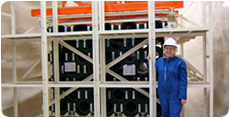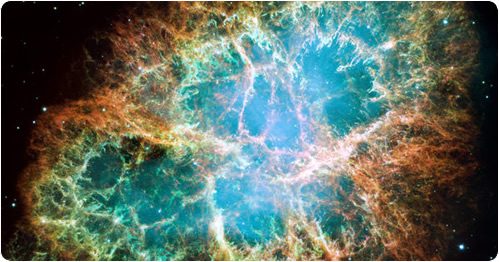

HALO (Helium and Lead Observatory) is a dedicated supernova neutrino detector that is presently under construction underground at SNOLAB in the Creighton Mine in Sudbury Ontario Canada.
It uses 79 tonnes of annular lead blocks instrumented with 128 tubular Helium-3 neutron detectors to detect neutrinos from supernovae within our galaxy. As a part of the worldwide Supernova Early Warning System (SNEWS), it will help detect supernovae by their neutrino burst, before their light reaches Earth, allowing time to notify both professional and amateur astronomers.

When a massive star (greater than 8 times the mass of our sun) collapses at the end of its life, it radiates approximately 99% of its energy in the form of neutrinos. These neutrinos come in all flavours, and are emitted over a timescale of several tens of seconds.
The neutrino signal emerges from the core of a star promptly after core begins to collapse, whereas the photon signal may take hours or days to emerge from the stellar envelope. The neutrino signal can therefore give information about the very early stages of core collapse, which is inaccessible to other kinds of astronomy. Unlike other particles neutrinos are antisocial and difficult to trap in a detector. Under typical conditions, a neutrino is 100 billion billion times less likely than light to interact with matter and a neutrino will pass straight through our planet Earth as effortlessly as the breeze through an open window. It is the weak interaction of neutrinos with matter that makes them uniquely valuable as astronomical messengers. Unlike photons or charged particles, neutrinos can emerge from deep inside a supernova and travel across the galaxy without interference. They are not deflected by interstellar magnetic fields and generally are not absorbed by intervening matter. However, this same trait makes supernovae neutrinos extremely difficult to detect.
![]()
What are neutrinos?
Ordinary matter is made of neutrons, protons, electrons and neutrinos. Neutrinos are emitted when neutrons transform into protons in nuclear reactions. They are produced in the nuclear reactions in the sun and in those ignited by the collapse of a dying star. They're so tiny that they can pass through solid matter without colliding with any molecules and they travel at close to the speed of light, making them incredible intergalactic messengers.
What are you hoping to find?
We are looking for neutrinos as a result of a gravitational collapse of a star in our galaxy. Correlating the number of the detected neutrinos with predicted events will help us explain their nature.
>> More Frequently Asked Questions













